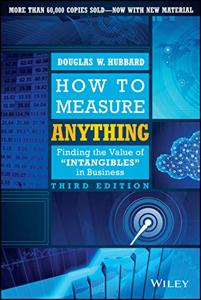
Want to learn the ideas in How to Measure Anything better than ever? Read the world’s #1 book summary of How to Measure Anything by Douglas W. Hubbard here.
Read a brief 1-Page Summary or watch video summaries curated by our expert team. Note: this book guide is not affiliated with or endorsed by the publisher or author, and we always encourage you to purchase and read the full book.
Video Summaries of How to Measure Anything
We’ve scoured the Internet for the very best videos on How to Measure Anything, from high-quality videos summaries to interviews or commentary by Douglas W. Hubbard.
1-Page Summary of How to Measure Anything
Introduction
If you’ve ever had to build a piece of furniture, balance a budget, or make a complex business decision, you know that measurements matter. A precise measurement can make the difference between an unfavorable outcome and success. But sometimes, you might find yourself dealing with materials that resist classification. In these cases, it’s either list them as immeasurable or look for innovative ways to approach the challenges they present. This book equips you with tools and techniques to measure anything – even elements that are intangible.
Questions are important to solve difficult problems. This is true in business and in life. Therefore, learning how to frame your problem effectively is the first step toward finding a solution. Whether you’re part of a business trying to measure customer satisfaction or an organization that’s looking at famine in developing countries, things that were once intangible become classifiable when they’re subjected to parameters and methods of observation.
Assessing the value of intangibles can be difficult, but using practical strategies will help you to reduce uncertainty and make better decisions. If you want to measure intangibles, this summary will show you how to generate and analyze more complete sets of information.
The Measurement Solution Exists
When we set out to measure something that is complex, it’s good to remember that many people have done so before us. For example, Eratosthenes did the impossible when he measured the circumference of Earth using only geometry and shadows. He discovered this by measuring shadows in Alexandria and calculating distances between Alexandria and other cities based on those measurements. Modern scientists have replicated his experiment with 97% accuracy. What was once considered unknowable has now become scientific fact due to rigorous observations like these.
Another example of using intuitive measurement methods to yield quantifiable results is known in scientific fields as Fermi decomposition. Enrico Fermi, a Nobel Prize-winning physicist, developed a process for approximating quantities that at first seemed unknowable. Once, he asked his students to estimate the number of piano tuners in Chicago. How could anyone know such a thing? Fermi urged them to begin with what they did know and work from there: Chicago had a population of 3 million people; at least 1 out of 30 households likely had pianos that were tuned once per year; one person can tune four or five pianos in one day; and 250 days are spent tuning each year. This put the range between 30 and 150 (piano tuners).
By looking at these examples, we can see that it is important to assess what you know and then make educated guesses about the information you don’t have. You must start any investigation by asking yourself what you do know. Experimentation is about making an attempt to learn something new, which may lead your inquiry into a direction that helps you discover things that were previously unknown.
Before You Measure
When it comes to difficult measurements, there are a few useful prerequisites to keep in mind. The following questions can help clarify your problem, so you can maintain your focus during the process: what decision will be made based on this measurement? What do you know about the measurement right now? What is your current level of uncertainty? These parameters allow you to frame your inquiry in the most useful way possible before you start tackling the problem. For example, when answering the first question about what decision will be made based on this measurement and defining all relevant variables for that decision, then that framework provides a useful context for how gather information and present it back to others. Similarly, by answering the second question — what do you know about this measurement right now — allows us to define our scope of research realistically.





